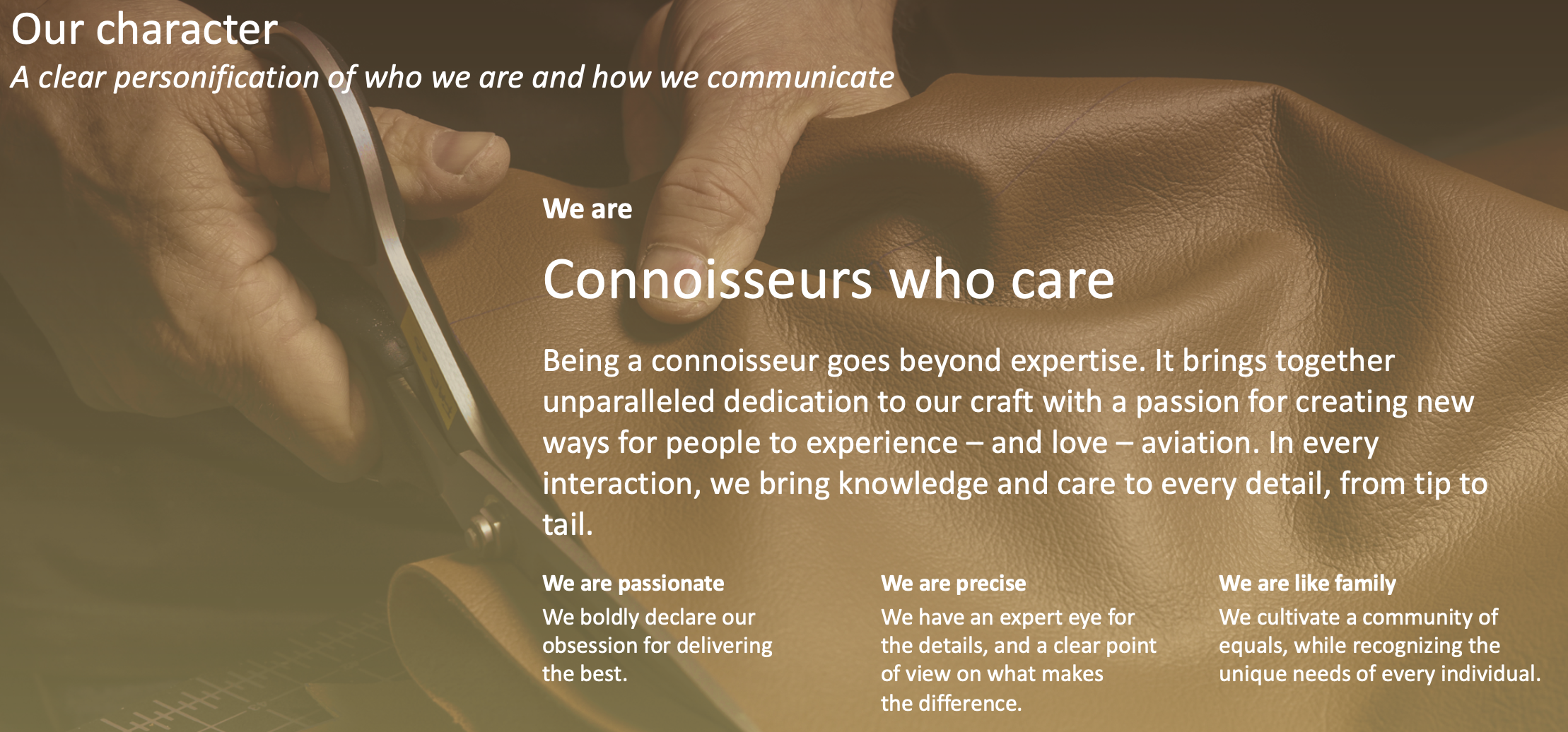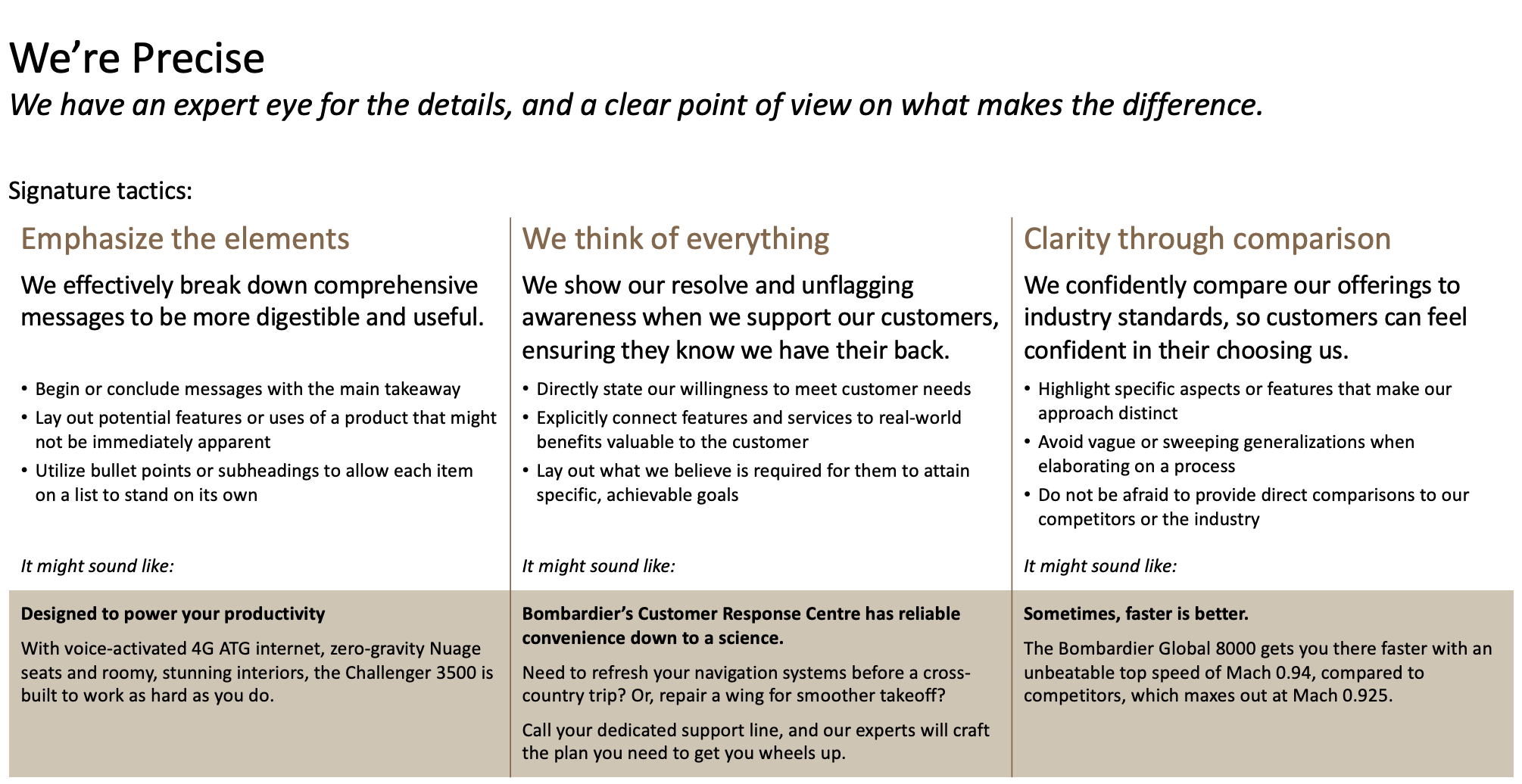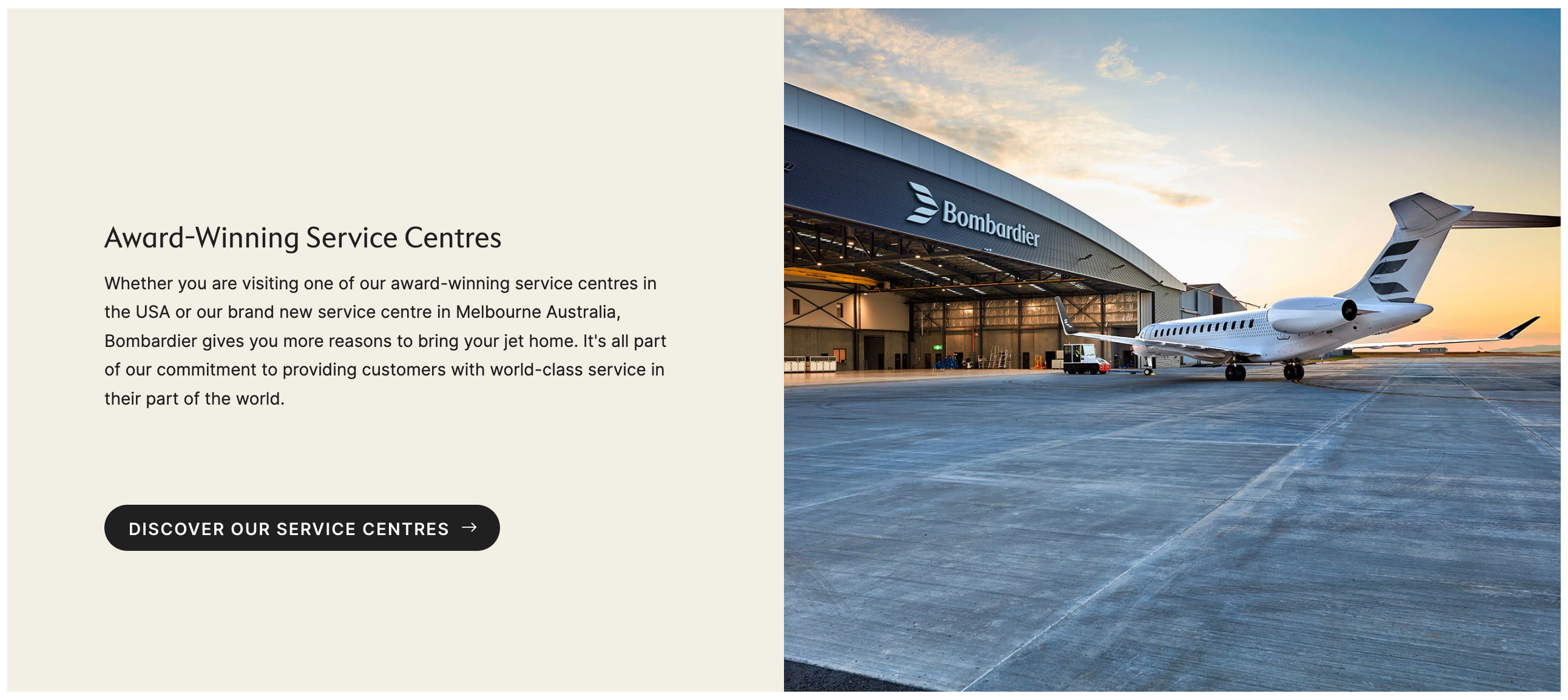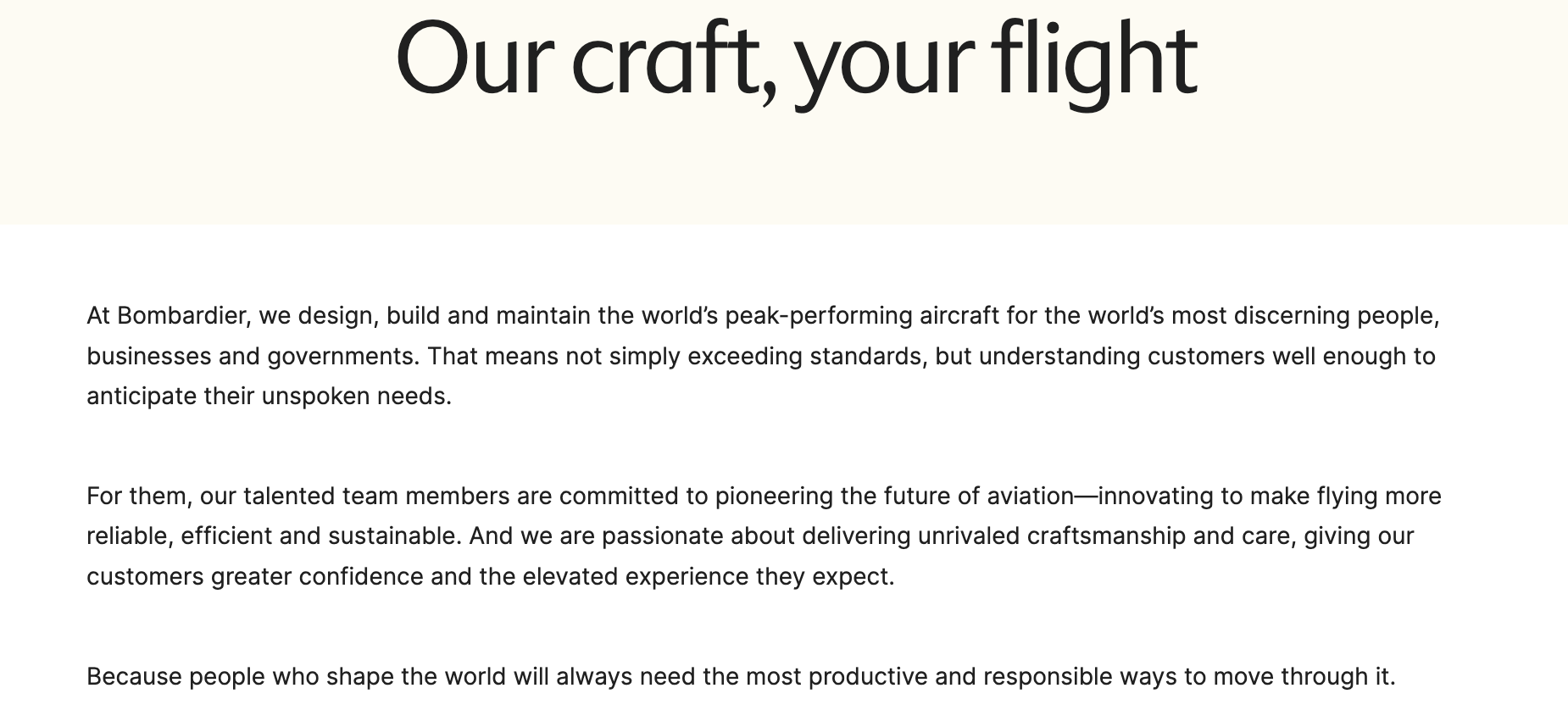Developed a scalable content strategy and voice system that transformed how Bombardier communicates across seven touchpoints, helping position them as a sophisticated lifestyle brand while maintaining technical credibility.
Key Details:
Role: Senior Brand Communications Strategist (sole voice strategist)
Timeline: December 2023 - April 2024
Team: Collaborated with brand strategists (architecture/messaging) and visual designers (identity system)
Methods: Behavioral research, pattern analysis, stakeholder workshops, content design
Deliverables: 9 tactical communication principles, multi-touchpoint content guidelines, implementation framework
Recognition: Red Dot Award (Best of the Best), Transform Awards Gold Medal, Applied Arts Design Award for Complete Rebrand
The Problem
In 2020, Bombardier refocused their business to become a pure-play business aviation leader. They had successfully repositioned their product portfolio—designing, building, and servicing exceptional aircraft for individuals, businesses, and governments worldwide. But their brand communications hadn't caught up.
The challenge: How do you transform a best-in-class product into a beloved brand?
What was at stake:
Bombardier needed their diverse audiences—customers, prospects, defense clients, investors, and employees—to recognize their evolution from a manufacturing-legacy company to an innovative aviation leader. Their communications were still anchored in their industrial past, disconnected from the sophisticated, experience-driven story they wanted to tell about their products.
The underlying tension:
The brand needed to work across vastly different contexts—from luxury private aviation to defense contracts. The voice needed to feel refined without being soft, driven without being overly intense, technically credible while remaining accessible. Getting this balance wrong could alienate key audience segments or dilute the brand's premium positioning.
My role:
I joined the project in December 2023 to develop the communications strategy and content guidelines. By this point, brand strategists had established the foundational brand architecture and messaging through stakeholder interviews and competitive analysis. My job was to translate that strategy into a practical, scalable system that Bombardier's teams could use independently.
Research & Discovery
When I joined the project, I inherited the brand architecture and positioning developed through earlier discovery work. The team had identified a clear brand idea through stakeholder research and competitive audits. My challenge was to figure out: What does this brand sound like in practice?
I analyzed approximately six figures across different industries—including Toto Wolff (Mercedes F1 Team Principal), David Chang (chef/entrepreneur), Phil Mickelson (golfer), and Padma Lakshmi (author/host)—through video content:
Why this approach? These individuals represented the aspirational qualities Bombardier wanted to embody—mastery, innovation, attention to detail, and a human touch. By studying how they naturally communicated, I could identify authentic patterns rather than manufacturing a corporate voice from scratch.
Key Research Insights
Through this analysis, I identified several communication patterns that became foundational to the strategy:
Owning mistakes and showing humility - These experts would include self-deprecating comments or acknowledge failures, which made them more relatable and trustworthy
Defining concepts to maintain inclusivity - They'd explain technical terms or industry concepts even when speaking to knowledgeable audiences, ensuring everyone could follow along
Process-oriented explanations - They broke down complex ideas methodically, often using numbered lists or clear frameworks
Heritage as motivation - Many spoke about upholding legacy or honoring tradition, connecting past excellence to future ambition
Synthesis Process
I presented these observational insights to my team through a structured format: introducing each figure, playing examples of their communication style, and proposing corresponding tactical principles for Bombardier.
For example: Toto Wolff spoke passionately about Mercedes' racing legacy and how upholding it drove the team forward. This insight led to the "Share our heritage" tactic—finding natural moments to weave Bombardier's innovation history into customer communications.
I validated each proposed tactic against the existing brand architecture to ensure alignment, then refined based on team and client feedback through iterative workshop presentations.
Defining the Strategy
Based on research insights and the established brand positioning, I organized the communication strategy around three core character values that would guide all content decisions: We’re Passionate, We’re Precise, We’re Like Family.
From here, I developed nine specific tactics that content creators could apply across touchpoints.
Structure of each tactic:
Clear principle name
One-sentence description
Three prescriptive bullet points detailing application possibilities
Original illustrative example showing the tactic in action
This structure ensured the system was both inspirational and immediately actionable.
The Solution
A Scalable Content Design System
For our teams’ comprehensive guidelines document, I also created a framework outlining tone-shaping communication goals and a framework laying out how to utilize the voice tactics alongside the pre-existing strategic messaging guidance.
To demonstrate how the system worked in practice, I created before-and-after content examples for:
Corporate website
Global brochure
Customer experience brochure
Employee communications (posters)
Social media posts
Thought leadership content
CEO letter to shareholders
For each example, I showed:
Original "before" copy on the left
Transformed "after" copy on the right
Callouts identifying which tactics were applied
Brand messages highlighted through underlining
Written explanation of strategic thinking using the messaging and voice framework
This format made the decision-making process transparent and teachable, allowing Bombardier's teams to apply the same thinking to new content.
Collaboration with Visual Design
Throughout the process, I coordinated with visual designers working on the logo and identity system. I provided written content to populate interface mockups they presented to clients, ensuring the verbal and visual brand worked cohesively. The voice needed to complement the elevated, refined aesthetic while adding warmth and accessibility.
Implementation Planning
The guidelines were designed for autonomous use—detailed enough that Bombardier's teams could apply the system without ongoing support. My work became part of the global training materials that leadership used to roll out the new brand, ensuring consistent adoption across the organization.
Impact & Results
Industry Recognition
The Bombardier rebrand received significant recognition in the design community, most notably:
Client Response
Observable Outcomes
Visiting Bombardier's current digital presence, the brand voice is noticeably warmer and more accessible than before. There's a refined balance—elegant and polished while maintaining attention to technical detail. Content across product descriptions, articles, and the About section demonstrates both the sophistication of a lifestyle brand and the credibility of an engineering leader.
Strategic Business Impact
The communications system helped Bombardier differentiate within the aerospace and defense sector by adopting communication patterns typically associated with luxury lifestyle brands. By emphasizing both cutting-edge engineering expertise and passion for customer experience, Bombardier elevated their positioning beyond pure technical capabilities.
Balancing range with focus:
The biggest challenge was creating a voice system that worked across dramatically different contexts—luxury private aviation and defense contracts. The voice needed to feel refined but not soft, driven but not overly intense. Studying those real-life connoisseurs helped me understand how to strike that balance authentically.
Working in a silo:
I operated fairly independently, brought in for a specific deliverable. While this gave me autonomy, it also meant I was somewhat insulated from other workstreams. I learned to be more proactive about engaging with both strategy and design teams, and to be adaptable as my understanding of the project evolved. In future work, I'd push for earlier and deeper integration with cross-functional teams—not to own other workstreams, but to understand their thinking and offer support where helpful.
What This Taught Me About Strategy
This project reinforced that strong strategy work requires both creative thinking and systematic application. The research phase let me explore and experiment, while the deliverable phase required rigorous organization and clarity. The most satisfying part was creating something scalable—a system others could use independently to make good decisions. That intersection of creativity and systematic thinking is what draws me to design strategy work.




















